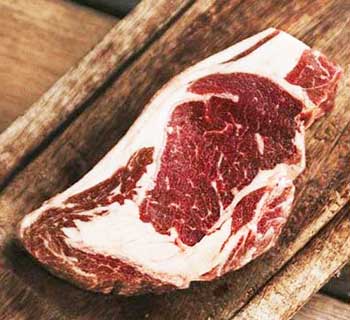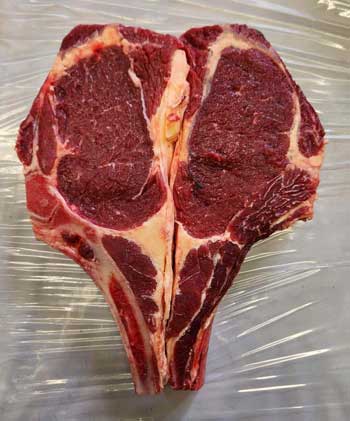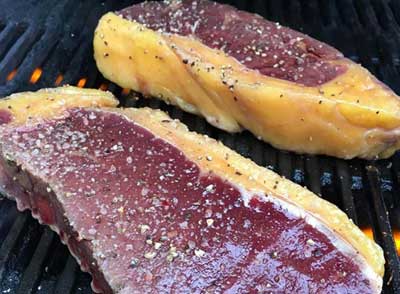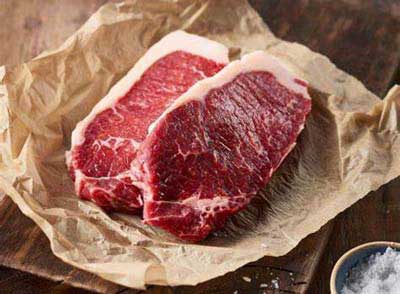Why is Our Bison Fat Yellow?
If you're used to seeing meat with nice white fat, then seeing yellow fat on our bison meat might raise some questions or concerns. But do not be alarmed, the yellow fat on our bison meat is actually a sign of its superior quality and nutritional value. It is because our bison are 100% Certified Grass-Fed. That means they have never been exposed to any grains or grain byproducts at any time during their entire life.

Notice the bright white color of the fat in this alleged grass-fed bison ribeye. The amount of fat would also indicate it is not grass-fed.

Notice the amount of fat and the yellowish color of the fat of this grass-fed bison ribeye.
The yellow color or yellowish tint of the fat in our bison meat is a result of the presence of beta-carotene (β-carotene), a natural plant pigment that is found in grass. When animals graze on green pastures, they consume β-carotene-rich foods, which are then stored in their fat. This results in the yellowish color of grass-fed fat. If the fat in your grass-fed meat is white, you should question whether or not the meat really comes from a grass-fed animal.
On the other end, grain-fed animals do not consume much β-carotene in their diet because finishing diets contain mostly grain and grain byproducts with very little forage, resulting in white fat. As a result, the fat of grain-fed meat lacks the yellowish color that is present in grass-fed animals.
The amount of yellow depends not only on the type of grasses consumed but also on age and sex of the animal as well as when the animal is harvested. The older the animal, the more β-carotene is stored in the fat and the darker the yellow color of the fat. Also, since cows tend to have more fat than bulls, the fat from a cow or heifer will generally be yellower than that of a bull.
The time of year the animal is harvested will also affect the amount of β-carotene (yellow color) of the fat. β-carotene is richest in fresh green grass but diminishes once cut and baled into hay. About 80% of the β-carotene is lost during curing and another 7-10% loss per month of hay storage. Thus, an animal consuming 2% of their body weight on green grass will consume about 3,000 milligrams of β-carotene per day but only about 300 milligrams of the same grass as hay.
Thus, the age and sex of the animal, the type of grass consumed, and when the animal is harvested will all determine how yellow the fat is. The color can range from a yellow tinge to solid yellow.
Other than the color, does the Yellow fat make a difference?
The yellow color of grass-fed fat is actually a sign of its superior quality and nutritional value.
β-carotene is an important antioxidant that helps protect the body against free radicals. It is also a natural precursor of Vitamin A, which the body can convert to Vitamin A as needed. This makes grass-fed meat a healthier and a natural way to increase Vitamin-A intake which is important for maintaining healthy vision, skin, and immune function. It also helps regulate gene expression and cell growth.
Grass-fed meat contains much less monounsaturated fat than their grain-fed counterparts and contains up to five times as much omega-3 fatty acids, which are linked to several health benefits. Additionally, grass-fed meat contains about twice as much conjugated linoleic acid (CLA) as grain-fed meat. CLA is another fatty acid associated with several health benefits including increasing fat metabolism leading to weight loss and is a potent anti-oxidant.
The yellow fat does affect the flavor of the meat. The flavor of meat is directly correlated to its diet, and animals consuming only grass will have a stronger "nutty" taste because the time of year that a grass-fed pastured animal is processed. Animals finished on healthy fresh grass will taste better and have more distinct and complex earthy undertones.
Furthermore, a major source of flavor in all meat comes from the fat. Grass-fed fat is packed with Omega-3s, CLA and TVA (super healthy fats), saturated fat, carotenoids, and trace minerals. The yellowish color of grass-fed fat is a sign that it is rich in β-carotene and other micro-nutrients that contribute to its superior flavor.
So, the yellow colored fat is not only good for you, but it is also one of the contributing micro-nutrients that gives grass fed bison meat its superior flavor.


Yellow fat is not unique to bison. Notice the yellow fat of the grass-fed beef strip steak on the left as compared to the white fat of the grain fed steak on the right.
Rod Chiodini, Ph.D.
Ozark Valley Bison Ranch LLC
Fox, AR
